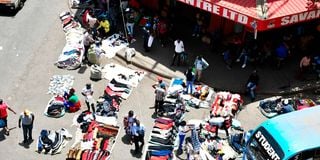Premium
Ghosts of the past as Sakaja allows hawkers back in Nairobi City Centre

Hawkers display their wares outside Savanis Bookshop on the junction of Lagos and Latema roads on February 25. The hawkers scramble for space on the road with motorists and pedestrians.
Nairobi is to witness a new phenomenon in days – hawkers will officially be allowed to operate on city centre alleys and lanes.
Plans are on course. Backstreet lanes are demarcated and names marked on some already. County government authorities say hawkers will take over the streets this month.
Governor Johnson Sakaja-led devolved government says the dignity of the hawkers will be improved and that pedestrians will have an easy time in the CBD.
City Hall has over the years carried out violent evictions of hawkers from the streets. In 2005, it was decided that hawkers be removed from the city centre.
Insecurity and the garbage menace in the City Centre were blamed on the thousands of hawkers operating from the streets. There were many short-term interventions before 2005.
Also Read: Why fixing Nairobi is a tall order
Later in 2007, President Mwai Kibaki officially opened the Sh700 million Muthurwa market as a solution to the Nairobi eyesore that the hawkers had become.
The opening of the market was meant to help decongest the City Centre. There were hardly any hawkers in the CBD after the opening of Muthurwa.
Unfortunately, it was a short-lived solution. The 10,000-capacity market on Landhies Road and Haile Sellasie Avenue soon became dirty, with poor drainage, bad lighting and insecurity.
Many traders now operate on the two roads, inconveniencing motorists, pedestrians and many other road users.
In the run-up to the 2017 General Election, the plight of hawkers became the then-senator Mike Sonko’s campaign tool. Mr Sonko, who was running for Nairobi governor against incumbent Francis Kidero, easily won the election.
The flamboyant politician, who sold himself as a solution to Nairobi’s many problems would soon after his victory propose that hawkers pay an annual fee of Sh2,000 for business permit, since the constitutional petition 3 of 2014 prohibited hawking. That too never worked.
Mr Sonko even came up with his radical plan of driving hawkers from the CBD to Mwariro market in Kariokor. That would serve as a permanent solution to the hawking menace in the CBD.
The idea was, however, met with strong opposition from Ziwani residents where Mwariro market is located. Mwariro serves small scale traders from Kariokor and neighbouring estates.
If successful, Governor Sakaja’s plan will see hawkers operate from designated spaces in the back lanes of the CBD, where they will sell their wares from 5pm daily.

Jonathan Kabiru, a hawker displays his wares on Turkana Lane in Nairobi on March 9, 2023.
Some Nairobi residents interviewed said the plan is not well thought out. Mr Kennedy Malimo, a local, said the backlanes are meant for disaster management responses.
“If something bad happens in the City Centre, there will be a stampede, which may lead to loss of lives. How will people escape? Matatus and other vehicles will be on the main roads while the lanes will be occupied by thousands of hawkers. County authorities know very well that the backlanes are loading zones and for disaster response purposes only,” Mr Malimo said.
“Economics tenets demand that corporate operations be conducted systematically. Hawking, however, defeats this principle. The Nairobi County government should charge hawkers who operate in the CBD. Unfortunately, this is futile as there is no workable structural strategy.”
The Nairobi City County Trade and Licensing Bill of 2018, Nairobi City County Pop Up markets and Street Vendors Bill of 2019 as well the Senate Hawkers Bill of 2019 have tried to standardise hawking.
The bills attempted to ensure hawkers are registered, pay permits and are provided with appropriate times and spaces to operate.
Every hawker was required to apply for a permit containing specific details of the goods they sold and place of operation.
A hawker found without a valid permit and in an undesignated place would have his or her wares seized.
Like other plans before, this one did not deter hawkers from getting into the City Centre and engaging in running battles with county enforcement officers, popularly known as kanjos.
According to Nairobi County Markets and Trade Chief Officer, Godfrey Akumali, the demarcation of the lanes will result in an orderly capital city.
Also Read: East Africa's boda boda mess
“It is in line with Governor Sakaja’s dream of a city of order and where every person is treated with dignity,” Mr Akumali said.
“We do not need to criminalise hawkers as they are earning a living from what they do, just like the rest of us.”
Most backlanes in the CBD have been converted into picking and dropping points by matatu operators.
The remaining few are not in a good state as they have become havens for pickpockets and muggers. Some are very dirty.
Other lanes like Meza, Jumba and Dodo are literally under lock and key. Meza Lane has been in such a condition for ages, with a rusty gate.
Business owners have blocked several lanes in the City Centre, with some even erecting gates and mounting closed-circuit television (CCTV) cameras to control and monitor movement.
Just behind the Nation Centre, for instance, several lanes intersecting with Kimathi Lane are controlled by traders.
In recent days, some of these spots have been earmarked and painted with the names of the hawkers already written in the spaces measuring 1.5 to two metres ahead of the official shift.
Mr Akumali defended the exercise, insisting that hawkers have been consulted and are part of it.
“We have been in contact with the leadership of the hawkers and they are part of this process. What differentiates what we are doing from what happened in the past is that we have involved the hawkers themselves. We also carried out public participation in September last year and agreed on what is being implemented,” he told the Saturday Nation.
However, many hawkers who spoke to the Saturday Nation that they are alien to any engagements with the county government with regards to their plight even as others support the new move.
Ms Millicent Njeri, who operates a tuck shop on Tom Mboya Street, said the initiative by Nairobi authorities is not new.
“Even previous administrations came up with many ideas but we chose to remain in the CBD. Some of the hawkers that you see here have been selling their wares since the days of (President Daniel arap) Moi. How can you move them to a site that has no traffic?” she asked.
Ms Jackline Okilo, another trader, said moving out of the City Centre “where I have operated for six years” will be difficult.
“We are aware of the plans. County government officials even took our names. This business relies on traffic,” she said.
But Mr George Kamau, a trader operating on Haile Selassie Avenue, had a different view.
“Before we are told to occupy those lanes, let them be spruced up,” he said.
“We don’t have any problem as long as they clean up those streets and make them secure. We support the programme.”
The county government intends to light up the backlanes.
“We will address lighting, hygiene and other concerns so that traders can feel secure. Even pedestrians will use these lanes. They avoid them because of insecurity and their poor state,” Mr Akumali said.





